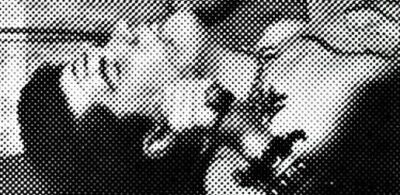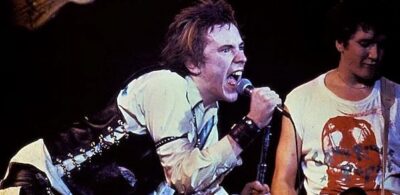The Avengers Open Your Eyes

Wild-eyed and frantic as she dressed for work early in the morning, my wife Jeannine caught me stumbling out of the bedroom sleepy-eyed, scratching my head and trying to remember a dream. She flung herself at me, grabbed me by my arms, and staring me square in the face, excitedly yelped: “What’s that punk song where the girl sings ‘Open Your Eyes, Open Your Eyes!!” Yup, just another day in my household.
I shook my head of dream shards, and paced a bit as I mumbled under my breath: “open your eyes… open your eyes.” The words were forming out of my drowsiness: “they tell you lies… and… you… sing… along.” I prodded myself, it was too early to play a question game, but, “I know this song, what is it?”
Suddenly it came to me, I felt like a kid getting knocked down by an ocean wave at any one of California’s polluted beaches. “AVENGERS! That’s it!!” The minutiae surrounding the song suddenly filled my head, names, dates, places, histories. Out of convenience I turned to the dreaded abyss of YouTube, typed “Avengers, Open Your Eyes,” and up popped the defiantly rebellious punk rock anthem from 1978.
The work-a-day-world preparations ceased momentarily as my wife and I eagerly listened to the punk rock oldie. Amazingly, that musical cry from the past summed up the problems of the present; it shrieked back against all the malfeasance, crookedness, venality, and depravity of today’s daily news—including contempt for the media itself. This was much more than teenage angst. Listen to the furious song and feel the indignation:
At first I thought you were dead, but now I see you’re one of the rest
they drugged you with muzak and TV sedation, you’re one of the blank generation(Refrain) Open your eyes, open your eyes, you don’t see what’s going on
come on, open your eyes, open your eyes
you watch TV to find out what’s right and wrong
yeah, open your eyes…well they tell you lies and you sing along
open your eyes, to what you respected
open your eyes, you can reject itI want to upset you, want to make you think, but you eat all their s**t
it makes your breath stink, gonna get a job, and join a f**king union
that way, you know, nothing’s gonna happen(Refrain)
Like lemmings you run, towards destruction
you can’t see the stream of corruption
oh I see, you’ve been blind
you better make up your mind(Refrain)
Think of this post as a time capsule of sorts. It holds a flyspeck cache of evidence that—once upon a time, art and culture, under the guise of punk rock, mounted a last gasp defense of liberty.
It is genuinely astonishing that the Avenger’s Open Your Eyes, a song of rage from America’s punk outburst of the late 70s, so effectively voices what millions of normal Americans are ruminating over in 2021. “Fake News”? Bah! Phfftt! In ’78 punks were shouting about the corporate media, “they tell you lies and you sing along!”
Granted, punk was an amorphous body of misfits; musicians, artists, writers, photographers, and guttersnipe philosophers. Mostly working class outsiders, we were a different breed of individualist oddballs unable to paint by the numbers. Down through the ages such eccentrics left in their wake inscrutable miscellanea—songs, writings, objects. This is no less so for punk. Social historians, or those who simply wish to nullify conformity and its ugly twin named obedience, should shift through the wreckage punk wrought. There are secrets to be found there.
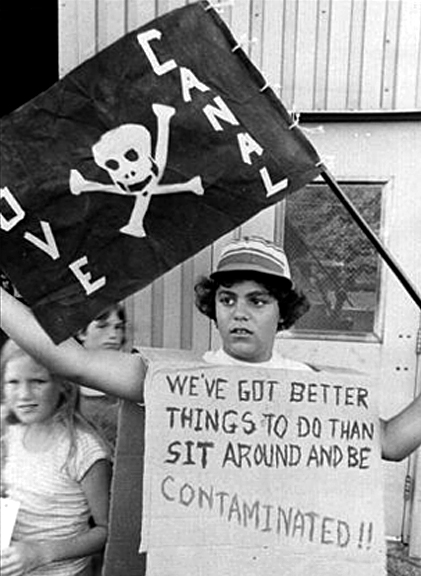
A case in point, Love Canal. That was a suburban community in Niagara Falls, New York. It was a neighborhood with higher than median income, access to schools and shopping areas, in many ways it epitomized the American Dream.
But no one ever told the people who purchased Love Canal homes that the community was built upon a massive toxic chemical dump. Around 200 tons of highly toxic dioxin had been dumped there. By 1975 eighty-two deadly chemicals—11 being carcinogens, leached into the top soil and groundwater to poison the population. High rates of miscarriages and birth defects were reported, and cases of epilepsy, asthma, migraines, and kidney disease soared.
In 1980 you could turn on commercial radio and hear hits like Magic by Olivia Newton-John, Do That to Me One More Time by Captain & Tennille, The Rose by Bette Midler, and Heartache Tonight by the Eagles.

I was listening to Love Canal in 1980, the first single released by the San Francisco terror noise punk outfit named Flipper. While acceptable pop celebrities were busy raking in the bucks with endless insipid love songs, Flipper was skulking about in underground venues wailing lyrics about the horrors of Love Canal: “We set sailing, drifting down the love canal. We seem strange, our bodies are breaking down.”
And so forever shall it be, the elites will bring you distractions and illusions, while the noble artist will alway bring you reality and truth—no matter how disquieting.
Yes, punk music made you squirm and twitch, either from delight or disgust. It delivered its uncomfortable message in a purposely excruciating, frenzied, and discordant way. It was meant as a musical slap to the face (“Open your eyes!”). Punk was always itching to fight, metaphorically speaking of course, but dominant culture gatekeepers thought it too contentious to be given a seat at the table of mainstream culture. Which is why you never heard of the Avengers or Flipper. The multitudes must be “drugged with muzak and TV sedation.”
I saw the Avengers play BACES Hall on April 18th, 1978 with the Flyboys and some neophyte band listed on the flyer only as “guests.” Turned out to be the Go-Go’s, like I said, dabblers. BACES was one of the few venues in LA that allowed punk concerts. The Avengers were a train blazing down the tracks to fly off the rails, their convulsive sound blasting through the sweaty horde of punks. A 1978 film captured a live Avengers performance; it is incorrectly labeled a performance at CBGB’s in New York City. The Avengers existed from 1977 to 1979, and the original band never toured beyond the West Coast. The film likely shows a gig at Geary Temple in San Francisco.
As with everything in Los Angeles, nothing is as it seems. In 1947 the Bulgarian American Cultural Education Society (BACES) was a non-profit corporation that promoted the culture and history of Bulgaria. The group rented a concert hall facility at 1530 N. Vermont Avenue in Los Angeles which they naturally enough named, BACES Hall. The group held classical music recitals, lectures, and readings that integrated Bulgarian traditions into American life. That early history has been entirely lost, in fact BACES Hall was torn down years ago and replaced with, what else, a Mini Mall.
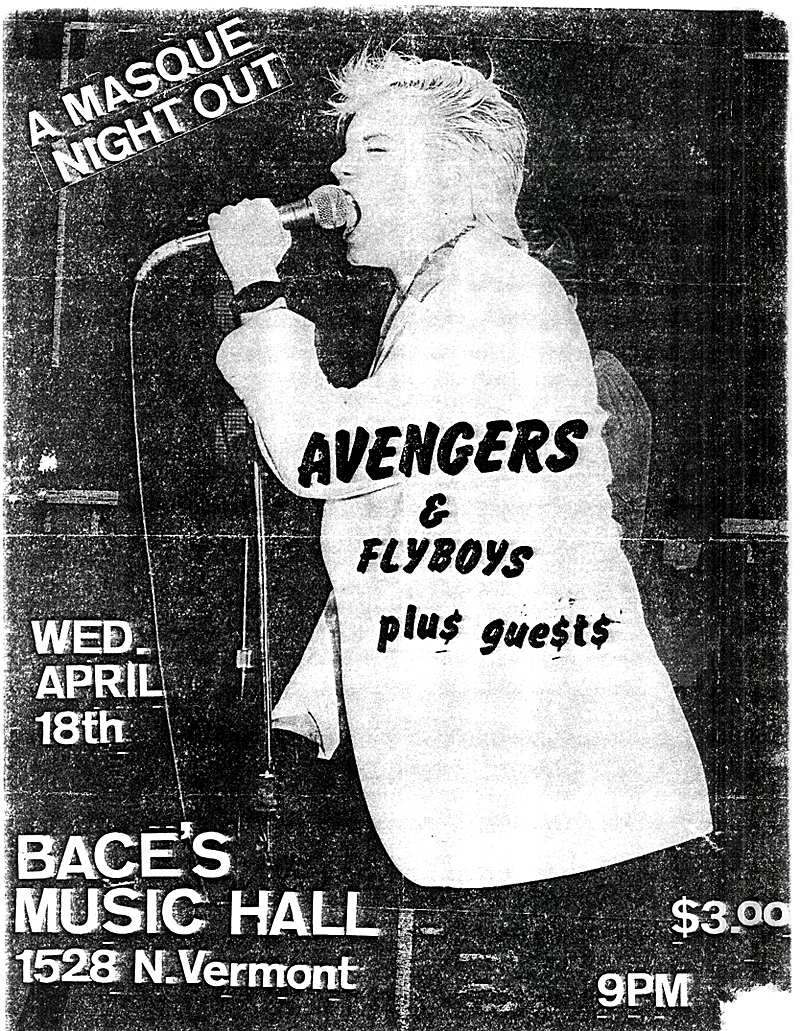
Way back in 1978 I found out about the Avengers gig at BACES Hall in the same way all the underground weirdos learned of the next riot, err, I mean “concert.” I happened upon a xerox flyer. And so, the last bit of this screed will briefly deal with the other component of the punk aesthetic that always mesmerized me as an artist, the do-it-yourself, primitive, and inexpert xerox flyer.
I have always been fascinated by the simple sketchy images intended to convey unorthodox ideas. The harsh imagery of the German Expressionists and DaDaists of the 1930s invariably got my attention. I was also heedful of the psychedelic graphics from the 1960s, particularly in the way they were distributed via posters and flyers. But the punk aesthetic hit home in a different way.
These were modern black and white images of nihilistic despair, sometimes comical, often cynical, always engaging. Riotous hodgepodges of news photos ripped from magazines and newspapers, combined with hostage letter fonts and juxtaposed with inane advertising images. Pretty near all the flyers were cheap xeroxes, heightening the critique that mass culture was fabricated and counterfeit. I appreciated that most were created by anonymous artists. I created a few myself.
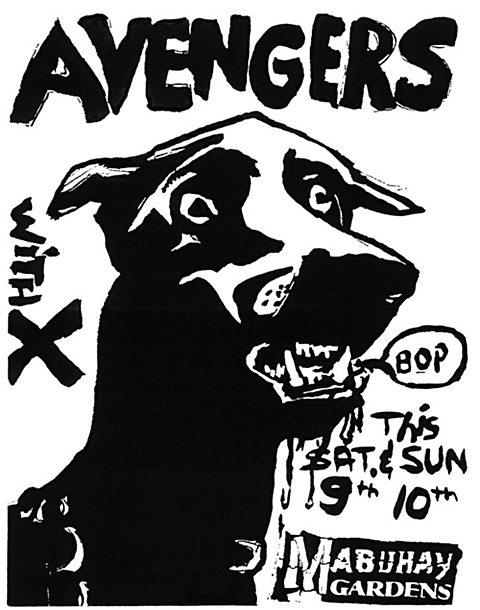
Some of my favorite punk flyers utilized singular images, some of them hand drawn, crudely or otherwise. They were artfully artless. Of late, social media has made the digital meme the sovereign of humorous if not troublesome graphics. I find some memes amusing, but there’s just something different about a handbill handcrafted by the human hand. Xerographic flyers do not rely on censorious High-Tech Overloads for distribution, and best of all, they can be left anywhere to intervene in daily life.
Perchance this essay will be taken as a crucial gift to seekers of esoteric knowledge and inspiration in dark times. On the other hand, I am tickled to death at the thought of those searching for the Avengers of Marvel Comics superhero fame… finding this essay instead.



